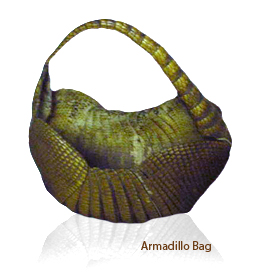About the case studies
You will work through three case studies. There are exercises which accompany them. You will receive feedback on each of these tasks before you attempt your final assessment.
[Instructions on how to submit this will be provided by the training provider]

An armadillo bag from the Man From Snowy River Museum, in the 'cabinet of curiosities' tradition
We use case studies because with problem based learning it is useful to start with a problem, a context, a group environment in which to explore issues and develop responses and resolutions (we encourage you to work with others) and a tutor.
The case study should provide the stimulus and context for the learning. You, the learner, are the active problem solver. You are the researcher. You seek information, collaborate with others, analyse your experiences and seek feedback.
For those undertaking this program of study who are not already working in a museum, the context is The Man from Snowy River museum.
Outline of the assessment requirements
Case study one
Here you are presented with a donor offering you an item to the The Man from Snowy River museum. You need to determine if the item should be accepted or not.
Case study two
In the second case study you observe the process of assessing significance through a number of steps. You will undertake research using the same process.
Case study three
In the third case study you look at significance criteria. You write a statement of significance with information given to you. This is an exercise in writing a statement of significance, making decisions and organising your information.
Assessment
Now you need to work on your own because this is an assessable item.
Choose an item from your local museum, research it and write a statement of significance.
The results of this assessment can be used towards determining your competence in the module ‘Research, describe and document cultural material'.
There is more information regarding this under the heading Your turn - assessment.